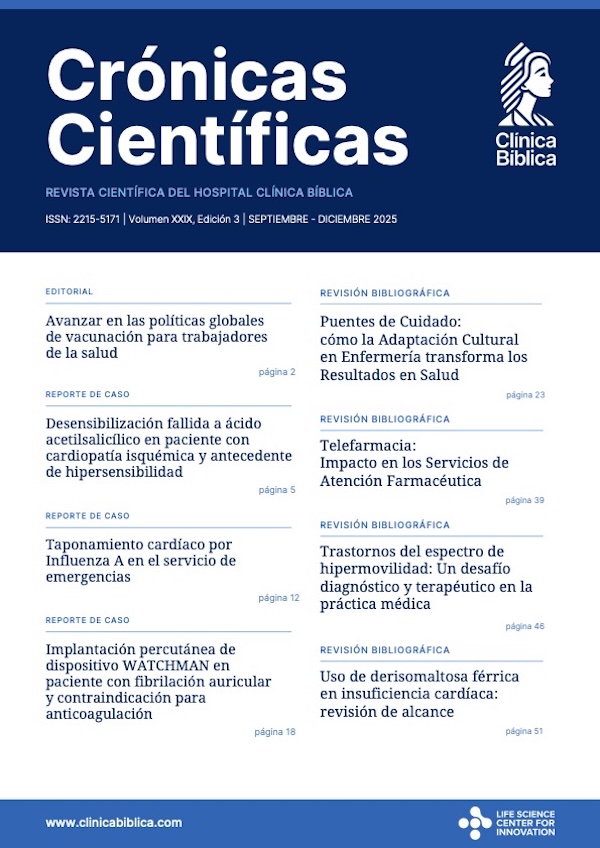- Visto: 947
Revisión Bibliográfica
Aplicaciones de la Inteligencia Artificial en Enfermería y su impacto en los Resultados del Cuidado: Una Revisión de Alcance.
Volumen XXIX, Edición 2, Mayo - Agosto 2025
DOI: https://doi.org/10.55139/NUAL8811
APA (7ª edición)
Vargas-Blanco, A. (2025). Aplicaciones de la inteligencia artificial en enfermería y su impacto en los resultados del cuidado: Una revisión de alcance. Crónicas Científicas. Revista Científica del Hospital Clínica Bíblica, 29(2), 41–52. https://doi.org/10.55139/NUAL8811.
Vancouver
Vargas-Blanco A. Aplicaciones de la inteligencia artificial en enfermería y su impacto en los resultados del cuidado: una revisión de alcance. Crónicas Científicas Rev Cient Hosp Clín Bíblica. 2025;29(2):41-52. doi:10.55139/NUAL8811
Avixely Vargas Blanco
Departamento de Enfermería - Investigación, Clínica Bíblica, San José, Costa Rica.
Resumen
La inteligencia artificial (IA) surge como una herramienta prometedora para mejorar la toma de decisiones en enfermería; sin embargo, persiste resistencia a su uso, especialmente en la práctica clínica, y falta evidencia sobre su impacto medido con taxonomías estandarizadas como la Nursing Outcomes Classification (NOC) o las Patient Reported Outcome Measures (PROMs). Esta revisión tuvo como objetivo sintetizar la evidencia sobre las aplicaciones de la IA en enfermería y su impacto en los resultados medidos mediante NOC o PROMs. Se realizó una revisión siguiendo la guía PRISMA-ScR, buscando estudios primarios publicados en los últimos cinco años en PubMed, ScienceDirect, Wiley Online Library, Dialnet y MDPI, tanto en inglés como en español. Se incluyeron estudios que emplearan herramientas de IA en práctica enfermera y reportaran resultados mediante NOC o PROMs. De 20 estudios seleccionados, 4 evaluaron directamente el uso de IA con PROMs y ninguno utilizó NOC de forma explícita, aunque varios estudios reportaron resultados implícitos relacionados con NOC o PROMs. La mayoría de los estudios se realizaron en entornos hospitalarios, principalmente en población adulta, con predominio de IA basada en aprendizaje automático. Las aplicaciones de IA identificadas incluyeron predicción de caídas, delirio, dolor crónico, riesgo de linfedema y optimización de intervenciones en cuidados paliativos. Aunque se identifican aplicaciones prometedoras, persiste heterogeneidad metodológica y escasez de estudios en otros contextos culturales. La IA tiene potencial para impactar positivamente la práctica de enfermería y la medición de resultados del cuidado, aunque su implementación requiere estandarización, validación y el empleo de taxonomías estandarizadas.
Palabras claves
Inteligencia artificial, enfermería, cuidado de enfermería, clasificación de resultados en enfermería, medición de resultados informados por el paciente.
Abstract
Artificial Intelligence (AI) emerges as a promising tool to enhance decision-making in nursing; however, resistance to its use persists, especially in clinical practice, and there is a lack of evidence regarding its impact when measured using standardized taxonomies such as the Nursing Outcomes Classification (NOC) or Patient Reported Outcome Measures (PROMs). This review aimed to synthesize the evidence on AI applications in nursing and their impact on outcomes measured through NOC or PROMs. A review was conducted following the PRISMA-ScR guidelines, searching for primary studies published in the last five years in PubMed, ScienceDirect, Wiley Online Library, Dialnet, and MDPI, in both English and Spanish. Studies were included if they used AI tools in nursing practice and reported outcomes using NOC or PROMs. Of the 20 selected studies, 4 directly evaluated the use of AI with PROMs, and none explicitly used NOC, although several studies reported implicit outcomes related to NOC or PROMs. Most studies were conducted in hospital settings, mainly in adult populations, with a predominance of machine learning-based AI. Identified AI applications included the prediction of falls, delirium, chronic pain, lymphedema risk, and optimization of interventions in palliative care. Although promising applications were identified, methodological heterogeneity and a lack of studies in other cultural contexts persist. AI has the potential to positively impact nursing practice and the measurement of care outcomes, although its implementation requires standardization, validation, and the use of standardized taxonomies.
Keywords
Artificial intelligence, nursing care, nursing, nursing outcomes classification, patient reported outcome measures.
Referencias
1. Cho I, Cho J, Hong JH, Choe WS, Shin HK. Utilizing standardized nursing terminologies in implementing an AI-powered fall-prevention tool to improve patient outcomes: a multihospital study. Journal of the American Medical Informatics Association. 2023;30(11):1826–36. doi: 10.1093/jamia/o- cad145
2. Kahraman H, Akutay S, Yüceler Kaçmaz H, Taşci S. Artificial Intelligence Literacy Levels of Perioperative Nurses: The Case of Türkiye. Nurs Health Sci. 2025;27(1):e70059. doi: 10.1111/N- HS.70059
3. Ruksakulpiwat S, Thorngthip S, Niyomyart A, Benjasirisan C, Phianhasin L, Aldossary H, et al. A Systematic Review of the Application of Artificial Intelligence in Nursing Care: Where are We, and What’s Next? J Multidiscip Healthc. 2024;17:1603–16. doi: 10.2147/JMDH.S459946
4. Wieben AM, Alreshidi BG, Douthit BJ, Sileo M, Vyas P, Steege L, et al. Nurses’ perceptions of the design, implementation, and adoption of machine learning clinical decision support: A descriptive qualitative study. Journal of Nursing Scholarship. 2024;57(1):82–94. doi: 10.1111/JNU.13001
5. Verma D, Jansen D, Bach K, Poel M, Mork PJ, d’Hollosy WON. Exploratory application of machine learning methods on patient reported data in the development of supervised models for predicting outcomes. BMC Med Inform Decis Mak. 2022;22(1):227. doi: 10.1186/s12911-022-01973-9
6. Haddaway NR, Page MJ, Pritchard CC, McGuinness LA. PRISMA2020: An R package and Shiny app for producing PRISMA 2020-compliant flow diagrams, with interactivity for optimised digital transparency and Open Synthesis. Campbell Systematic Reviews. 2022;18(2):e1230. Available from: https://doi.org/10.1002/cl2.1230
7. Dong L, Hirayama H, Zheng XJ, Masukawa K, Miyashita M. Using voice recognition and machine learning techniques for detecting patient-reported outcomes from conversational voice in palliative care patients. Japan Journal of Nursing Science. 2025;22(1):e12644. doi: 10.1111/jjns.12644
8. Verma D, Bach K, Mork PJ. External validation of prediction models for patient-reported outcome measurements collected using the SELFBACK mobile app. Int J Med Inform. 2023;170:104936. doi: 10.1016/j.ijmedinf.2022.104936
9. Sandham MH, Hedgecock EA, Siegert RJ, Narayanan A, Hocaoglu MB, Higginson IJ. Intelligent Palliative Care Based on Patient-Reported Outcome Measures. J Pain Symptom Manage. 2022;63(5):747–57. doi: 10.1016/j.jpainsymman.2021.11.008
10. Ramsdale E, Zhou Y, Smith L, Xu H, Tylock R, Flannery M, et al. Unsupervised learning to identify symptom clusters in older adults undergoing chemotherapy. J Geriatr Oncol. 2025;16(3):102222. doi: https://doi.org/10.1016/j.j- go.2025.102222
11. Kim MS, Kang M. Development and Effectiveness of a Clinical Decision Support System for Postembolization Syndrome after Transarterial Chemoembolization: A Randomized Controlled Trial. Asian Nurs Res (Korean Soc Nurs Sci). 2025;S1976-1317:39–8. doi: 10.1016/j.anr.2025.03.008
12. Hughes JA, Wu Y, Jones L, Douglas C, Brown N, Hazelwood S, et al. Analyzing pain patterns in the emergency department: Leveraging clinical text deep learning models for real-world insights. Int J Med Inform. 2024;190:105544. doi: 10.1016/j.ijmedinf.2024.105544
13. Lindberg DS, Prosperi M, Bjarnadottir RI, Thomas J, Crane M, Chen Z, et al. Identification of important factors in an inpatient fall risk prediction model to improve the quality of care using EHR and electronic administrative data: A machine-learning approach. Int J Med Inform. 2020;143:104272. doi: 10.1016/j.ijmedinf.2020.104272
14. Jahandideh S, Hutchinson AF, Bucknall TK, Considine J, Driscoll A, Manias E, et al. Using machine learning models to predict falls in hospitalised adults. Int J Med Inform. 2024;187:105436. doi: 10.1016/j.ijmedinf.2024.105436
15. Sung SF, Hsieh CY, Hu YH. Early Prediction of Functional Outcomes After Acute Ischemic Stroke Using Unstructured Clinical Text: Retrospective Cohort Study. JMIR Med Inform. 2022;10(2):e29806. doi: 10.2196/29806
16. Lei L, Zhang S, Yang L, Yang C, Liu Z, Xu H, et al. Machine learning-based prediction of delirium 24 h after pediatric intensive care unit admission in critically ill children: A prospective cohort study. Int J Nurs Stud. 2023;146:104565. doi: 10.1016/j.ijnurstu.2023.104565
17. Kawashima A, Furukawa T, Imaizumi T, Morohashi A, Hara M, Yamada S, et al. Predictive Models for Palliative Care Needs of Advanced Cancer Patients Receiving Chemotherapy. J Pain Symptom Manage. 2024;67(4):306-316.e6. doi: 10.1016/j.jpainsymman.2024.01.009
18. Wu X, Guan Q, Cheng ASK, Guan C, Su Y, Jiang J, et al. Comparison of machine learning models for predicting the risk of breast cancer-related lymphedema in Chinese women. Asia Pac J Oncol Nurs. 2022;9(12):100101. doi: 10.1016/j.apjon.2022.100101
19. Hur S, Ko RE, Yoo J, Ha J, Cha WC, Chung CR. A machine learning-based algorithm for the prediction of intensive care unit delirium (PRIDE): Retrospective study. JMIR Med Inform. 2021;9(7):e23401. doi: 10.2196/23401
20. Abujaber AA, Yaseen S, Nashwan AJ, Akhtar N, Imam Y. Prediction of stroke-associated hospital-acquired pneumonia: Machine learning approach. Journal of Stroke and Cerebrovascular Diseases. 2025;34(2):108200. doi: 10.1016/j.jstrokecerebrovasdis.2024.108200
21. Meng L, Wei T, Fan R, Su H, Liu J, Wang L, et al. Development and validation of a machine learning model to predict venous thromboembolism among hospitalized cancer patients. Asia Pac J Oncol Nurs. 2022;9(12):100128. doi: 10.1016/j.apjon.2022.100128
22. Conway A, Jungquist CR, Chang K, Kamboj N, Sutherland J, Mafeld S, et al. Predicting Prolonged Apnea During Nurse-Administered Procedural Sedation: Machine Learning Study. JMIR Perioper Med. 2021;4(2):e29200. doi: 10.2196/29200
23. Jin S, Qin D, Wang C, Liang B, Zhang L, Gao W, et al. Develop- ment, validation, and clinical utility of risk prediction models for cancer-associated venous thromboembolism: A retrospective and prospective cohort study. Asia Pac J Oncol Nurs. 2025;12:100691. doi: 10.1016/j.apjon.2025.100691
24. Chen C, Lam KT, Yip KM, So HK, Lum TYS, Wong ICK, et al. Comparison of an AI Chatbot With a Nurse Hotline in Reducing Anxiety and Depression Levels in the General Population: Pilot Randomized Controlled Trial. JMIR Hum Factors. 2025;12:e65785. doi: 10.2196/65785
25. Odhiambo CO, Ablonczy L, Wright PJ, Corbett CF, Reichardt S, Valafar H. Detecting Medication-Taking Gestures Using Machine Learning and Accelerometer Data Collected via Smartwatch Technology: Instrument Validation Study. JMIR Hum Factors. 2023;10:e42714. doi: 10.2196/42714
26. O’Connor S, Vercell A, Wong D, Yorke J, Fallatah FA, Cave L, et al. The application and use of artificial intelligence in cancer nursing: A systematic review. European Journal of Oncology Nursing. 2024;68:102510. doi: 10.1016/j.ejon.2024.102510
27. Robert N. How artificial intelligence. Nurs Manage. 2019;50(9):30–9. doi: https://doi.org/10.1097/01.NUMA.0000578988.56622.21
28. Dos Santos FC, Johnson LG, Madandola OO, Priola KJB, Yao Y, MacIeira TGR, et al. An example of leveraging AI for documen- tation: ChatGPT-generated nursing care plan for an older adult with lung cancer. Journal of the American Medical Informatics Association. 2024;31(9):2089–96. doi: 10.1093/jamia/ocae116
29. Wang T, Mu J, Chen J, Lin CC. Comparing ChatGPT and clinical nurses’ performances on tracheostomy care: A cross-sectional study. Int J Nurs Stud Adv. 2024;6:100181. doi: 10.1016/j.ijnsa.2024.100181
30. Saban M, Dubovi I. A comparative vignette study: Evaluating the potential role of a generative AI model in enhancing clinical decision-making in nursing. J Adv Nurs. 2024;1–11. doi: 10.1111/JAN.16101
31. Churruca K, Pomare C, Ellis LA, Long JC, Henderson SB, Murphy LED, et al. Patient-reported outcome measures (PROMs): A review of generic and condition-specific measures and a discussion of trends and issues. Health Expectations. 2021;24(4):1015–24. doi: 10.1111/hex.13254
32. Oh EG, Oh S, Cho S, Moon M. Predicting Readmission Among High-Risk Discharged Patients Using a Machine Learning Model With Nursing Data: Retrospective Study. JMIR Med Inform. 2025;13:e56671. [accessed 7 Jul 2025] Available from: https://www.sciencedirect.com/science/article/pii/S2291969425000468
33. Ivanov O, Wolf L, Brecher D, Lewis E, Masek K, Montgomery K, et al. Improving ED Emergency Severity Index Acuity Assignment Using Machine Learning and Clinical Natural Language Processing. J Emerg Nurs. 2021;47(2):265-278.e7. doi: 10.1016/j.jen.2020.11.001
34. Yang L, Peilong C, Xin L, Hongzhang J, Juan H, Yujuan W, et al. Design and Development of a Fully Intelligent Nursing Information System Based on International Standard Nursing Terminology. Stud Health Technol Inform. 2024;315:31–6. doi: 10.3233/SHTI240101
35. Cho I, Jin I sun, Park H, Dykes PC. Clinical impact of an analytic tool for predicting the fall risk in inpatients: Controlled interrupted time series. JMIR Med Inform. 2021;9(11):e26456. doi: 10.2196/26456
36. Karaçay P, Goktas P, Yaşar Ö, Uyanik B, Uzlu S, Coşkun K, et al. Investigation of Pressure Injuries With Visual ChatGPT Integration: A Descriptive Cross-Sectional Study. J Adv Nurs. 2025;1–14. doi: 10.1111/JAN.16905
37. Mohammed HT, Corcoran K, Lavergne K, Graham A, Gill D, Jones K, et al. Clinical, Operational, and Economic Benefits of a Digitally Enabled Wound Care Program in Home Health: Quasi-Experimental, Pre-Post Comparative Study. JMIR Nurs. 2025;8(1):e71535. doi: 10.2196/71535
38. Lei C, Jiang Y, Xu K, Liu S, Cao H, Wang C. Convolutional Neural Network Models for Visual Classification of Pressure Ulcer Stages: Cross-Sectional Study. JMIR Med Inform. 2025;13:e62774. doi: 10.2196/62774
39. Jiang M, Ma Y, Guo S, Jin L, Lv L, Han L, et al. Using Machine Learning Technologies in Pressure Injury Management: Systematic Review. JMIR Med Inform. 2021;9(3):e25704. doi: 10.2196/25704
40. Chae S, Davoudi A, Song J, Evans L, Bowles KH, Mcdonald M V., et al. Developing a clinical decision support framework for integrating predictive models into routine nursing practices in home health care for patients with heart failure. Journal of Nursing Scholarship. 2025;57(1):165–77. doi: 10.1111/JNU.13030
41. Cheng W, Zheng J, Lu Y, Chen G, Zhu Z, Wu H, et al. Machine learning models to predict 6-month mortality risk in home-based hospice patients with advanced cancer. Asia Pac J Oncol Nurs. 2025;12:100679. doi: 10.1016/j.apjon.2025.100679
42. Wu Y, Li F, Shu H, Li S, Cui L, Tan M, et al. Identifying the key influencing factors of psychological birth trauma in primiparous women with interpretable machine learning. Int J Nurs Sci. 2025;12(3):253–60. doi: 10.1016/j.ijnss.2025.04.008
43. Hani SB, Ahmad M. Effective Prediction of Mortality by Heart Disease Among Women in Jordan Using the Chi-Squared Automatic Interaction Detection Model: Retrospective Validation Study. JMIR Cardio. 2023;7:e48795. doi: 10.2196/48795
44. Yoo J, Kim SH, Hur S, Ha J, Huh K, Cha WC. Candidemia risk prediction (CanDETEC) model for patients with malignancy: Model development and validation in a single-center retrospective study. JMIR Med Inform. 2021;9(7):e24651. doi: 10.2196/24651
45. Wilson PM, Ramar P, Philpot LM, Soleimani J, Ebbert JO, Storlie CB, et al. Effect of an Artificial Intelligence Decision Support Tool on Palliative Care Referral in Hospitalized Patients: A Randomized Clinical Trial. J Pain Symptom Manage. 2023;66(1):24–32. doi: 10.1016/j.jpainsymman.2023.02.317
46. Oh SS, Kang B, Hong D, Kim JI, Jeong H, Song J, et al. A Multivariable Prediction Model for Mild Cognitive Impairment and Dementia: Algorithm Development and Validation. JMIR Med Inform. 2024;12:e59396. doi: 10.2196/59396
47. Matsumoto K, Nohara Y, Sakaguchi M, Takayama Y, Fukushige S, Soejima H, et al. Temporal Generalizability of Machine Learning Models for Predicting Postoperative Delirium Using Electronic Health Record Data: Model Development and Validation Study. JMIR Perioper Med. 2023;6(1):e50895. doi: 10.2196/50895
48. Dai L, Wu Z, Pan X, Zheng D, Kang M, Zhou M, et al. Design and implementation of an automatic nursing assessment system based on CDSS technology. Int J Med Inform. 2024;183:105323. doi: 10.1016/j.ijmedinf.2023.105323 Oh EG, Oh S, Cho S, Moon M. Predicting Readmission Among High-Risk Discharged Patients Using a Machine Learning Model With Nursing Data: Retrospective Study. JMIR Med Inform. 2025;13:e56671. [accessed 7 Jul 2025] Available from: https://www.sciencedirect.com/science/article/pii/S2291969425000468
49. Yüceler Kaçmaz H, Kahraman H, Akutay S, Dağdelen D. Development and Validation of an Artificial Intelligence–Assisted Patient Education Material for Ostomy Patients: A Methodological Study. J Adv Nurs. 2025;81(7):3859–67. doi: 10.1111/JAN.16542
50. Park JI, Johnson S, Pruinelli L. Optimizing pain management in breast cancer care: Utilizing ‘All of Us’ data and deep learning to identify patients at elevated risk for chronic pain. Journal of Nursing Scholarship. 2025;57(1):95–104. doi: 10.1111/- JNU.13009
51. Kim M, Kim Y, Choi M. Intensive care unit nurses’ experiences of nursing concerns, activities, and documentation on patient deterioration: A focus-group study. Australian Critical Care. 2025;38(2). doi: 10.1016/j.aucc.2024.09.011
APA (7ª edición)
Vargas-Blanco, A. (2025). Aplicaciones de la inteligencia artificial en enfermería y su impacto en los resultados del cuidado: Una revisión de alcance. Crónicas Científicas. Revista Científica del Hospital Clínica Bíblica, 29(2), 41–52. https://doi.org/10.55139/NUAL8811.
Vancouver
Vargas-Blanco A. Aplicaciones de la inteligencia artificial en enfermería y su impacto en los resultados del cuidado: una revisión de alcance. Crónicas Científicas Rev Cient Hosp Clín Bíblica. 2025;29(2):41-52. doi:10.55139/NUAL8811
Esta obra está bajo una licencia internacional Creative Commons: Atribución-NoComercial-CompartirIgual 4.0 Internacional (CC BY-NC-SA 4.0)

Realizar búsqueda
Última Edición
Ediciones Anteriores






